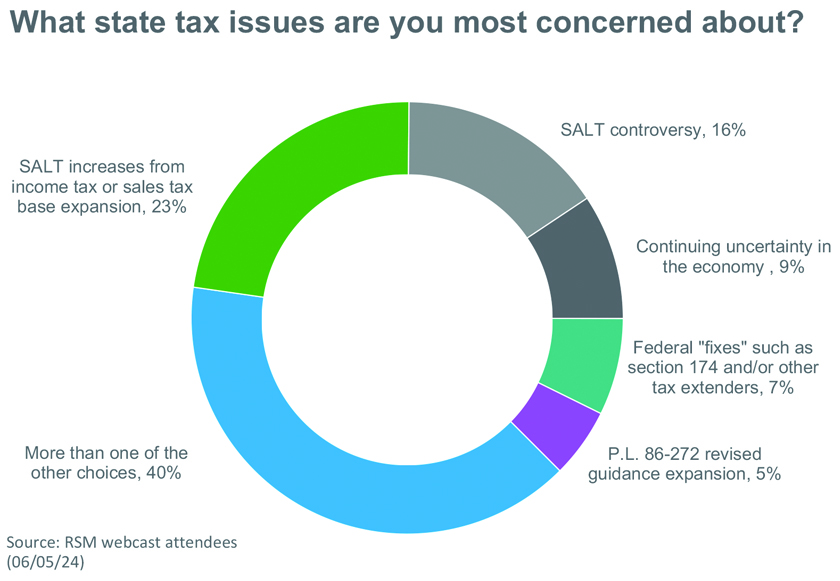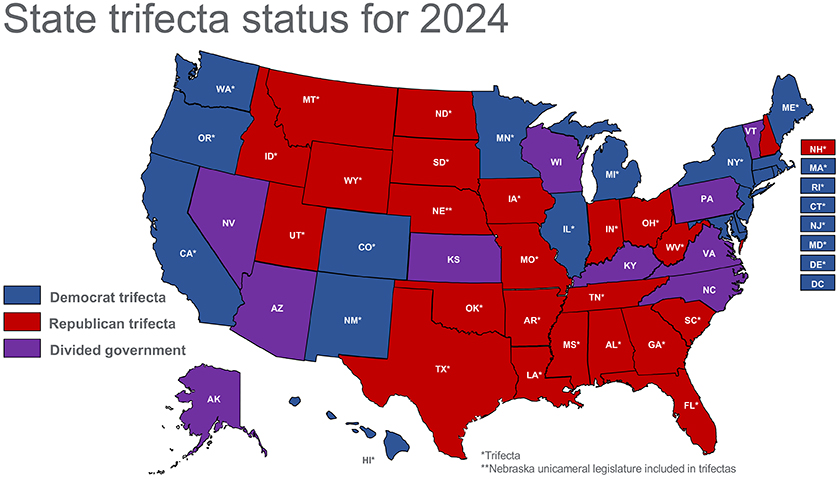10 observations about state tax entering the second half of 2024

There’s more sunshine than clouds over the state tax landscape halfway through 2024. States’ rainy-day funds are at near-historic highs. Authorities are shoring up state revenues through enforcement efforts in lieu of sweeping trends toward tax rate increases or base expansions. And although macroeconomic conditions present uncertainty as usual, resilient consumer trends bode well for sales tax revenues.
“I’m not holding my breath and closing my eyes hoping we get out of 2024,” RSM State and Local Tax Partner Brian Kirkell says with a nod to developments in 2020 that continue to shape state tax dynamics. “I feel like we’re doing all right in 2024.”
Here are 10 observations about state taxes as we move into the second half of the year.
1. State fiscal situations generally are back to normal—and that’s a good thing.
Most states have steadied following three bumpy years. There was the bust of the pandemic, then the boom of federal relief money, followed by significant economic uncertainty.
And now?
“There is a mix of good and bad, but I would argue that’s normal,” Kirkell says. “We should all be happy to see normal. I feel pretty good because the outlook is more predictable than it’s been in years.”
Yearly state revenues have snapped back to pre-pandemic trends, reestablishing a familiarity that eases planning—although overall state tax collections have stagnated more recently.
Also, states’ rainy-day funds are about as well-funded as ever. They amounted to $155 billion in fiscal year 2023, compared to $68 billion in fiscal 2017, according to the National Association of State Budget Officers. That safety net is compelling states to spend.
“When states take money out of reserve, it normally results in either tax cuts, infrastructure spending or something that’s good for business,” Kirkell says.
2. Small or negative real growth in states’ annual revenues could leave states vulnerable.
Calendar year 2023 was a rare down year for overall state and local tax (SALT) collections. Meanwhile, more than a dozen states cut taxes. Many states had sales or gas tax holidays. Some gave income tax rebates. According to the Center on Budget and Policy Priorities, the rate cutting has been historically large in size and scope.
For the wary, this dynamic leaves states susceptible to a variety of potential disruptions.
“States could be put in a tough position if there are some macroeconomic or geopolitical challenges such as rising unemployment or poor market performance—because overall we’re not seeing tax increases,” says Mo Bell-Jacobs, senior manager in RSM’s SALT practice.

3. Sales tax revenues remain steady and fairly predictable.
Relative quiet on the sales tax front illustrates states—both red and blue—are not rushing to raise sales tax revenues.
Sales tax revenues correlate with consumer spending, which remains resilient. Meanwhile, states have essentially fully implemented requirements stemming from the Wayfair ruling in 2018, so they are collecting on transactions.
“You usually see a bunch of proposals to tax professional services and things like that,” says David Brunori, senior director in RSM’s SALT practice. “We haven’t seen a lot of them in the past year, and I don’t really see many coming up in the next year. Everyone seems to still be in a tax-cutting mode.”
On the other hand, taxes on digital goods are evolving as the digital economy becomes a larger component of consumer and business activity. States continue to expand their bases through so-called sin taxes, such as those on marijuana and gambling. And it’s worth monitoring a potential shift toward taxing services.
4. An expected pause in corporate income tax decreases has not occurred.
States continue to enact statutory rate reductions. There still are other, sporadic efforts to shore up corporate tax revenues—such as limiting deductions of net-operating losses in some states or Connecticut’s extension last year of a 10% corporate business tax surcharge. But on a wide scale, states’ encouraging fiscal health is lowering the floor beneath corporate rates.
5. Audit activity and tax controversy matters are intensifying in lieu of tax increases.
States are not increasing taxes, but they’re not flush with revenue either. Their avenue to strengthen budgets, then, is through enforcement.
“The audits are going to get more aggressive, and the states are going to be more active in pushing toward litigation,” Kirkell says. “We have seen only the tip of the iceberg.”
Brunori expects the increase in audits to transcend political lines among states. Revenue departments in the past struggled to keep pace with evolving business practices, but that is changing. Taxing authorities are becoming savvier with better resources.
“The decision whether to fight an audit or concede or settle may just become more of a cost-benefit analysis than simply fighting on the technical merits,” says Amy Letourneau, senior manager in RSM’s SALT practice.
6. It’s worth bookmarking some state races in the upcoming general election.
Unlike tax policy at the federal level, state tax policy commonly needs only a simple majority to pass. With fewer barriers to enactment, state tax priorities commonly advance, given that 40 states have a so-called trifecta in which one party controls the executive branch and both legislative chambers.
Two divided states could join that list of trifectas depending on the results of their respective gubernatorial races in November.
In North Carolina, where Republicans control the legislature, Democratic governor Roy Cooper is term limited. In Vermont, where Democrats control the legislature, Republican governor Phil Scott seeks a fifth term.
Overall, 80% of all state legislative seats are up for grabs this fall, and there are 11 gubernatorial races.

7. Nexus is ever-present for growing businesses.
State departments of revenue operate in a post-nexus world. As a result, taxpayers need to regularly evaluate on a state-by-state basis how they interact with such nexus criteria as transaction thresholds, marketplace requirements and factor presence standards.
“I used to say you could refresh your analysis and think about this every couple of years,” Kirkell says. “But now it’s every year.”
As states continue to refine various nexus rules, there is a deepening focus on apportionment and sourcing. How a business sources each of its revenue streams affects its state tax profile more than whether it has a physical presence in a state.
“Taxpayers have a lot of work to do around apportionment, especially sales factor sourcing, and it’s becoming increasingly complex,” Letourneau says.
8. Novel digital tax expansion continues.
States are having mixed success with proposals to tax components of the digital economy, such as advertising, social media and data mining. Digital goods, products and services are still targets, while digital assets have flummoxed the states.
“This is an area ripe for state intervention,” Bell-Jacobs says.
Several groups, including the Multistate Tax Commission (MTC), have recognized the need for greater uniformity in taxation of the digital economy, but action to substantially benefit taxpayers in the near term seems unlikely.
9. State taxing authorities are aggressively targeting interstate business activity that taxpayers claim is protected under federal law.
States are looking closer than ever at cross-border nonsales activities that businesses believe are protected from income tax under Public Law 86-272.
The MTC in 2021 issued guidance to try to apply the 1959 law to business practices in the digital economy. “This has given states a new arrow in the quiver,” says Brunori, who expects audit activity in this area to continue to increase.
10. Pass-through-entity-level tax workaround modifications are helping taxpayers.
Many states are improving the pass-through-entity-level tax workarounds they enacted earlier after federal legislation in 2017 limited individuals’ SALT deductions.
Updated rates, deadlines and, in some cases, changes of credits from nonrefundable to refundable, are reasons for taxpayers to reexamine the election whether to pay pass-through income tax at the entity level.
Notably, the workarounds in about 25 states would still be law if the SALT deduction cap expires in 2025, as scheduled.
This article was written by Brian Kirkell, David Brunori, Mo Bell-Jacobs, Amy Letourneau and originally appeared on 2024-08-05. Reprinted with permission from RSM US LLP.
© 2024 RSM US LLP. All rights reserved. https://rsmus.com/insights/services/business-tax/10-observations-about-state-tax-entering-the-second-half-of-2024.html
RSM US LLP is a limited liability partnership and the U.S. member firm of RSM International, a global network of independent assurance, tax and consulting firms. The member firms of RSM International collaborate to provide services to global clients, but are separate and distinct legal entities that cannot obligate each other. Each member firm is responsible only for its own acts and omissions, and not those of any other party. Visit rsmus.com/about for more information regarding RSM US LLP and RSM International.
The information contained herein is general in nature and based on authorities that are subject to change. RSM US LLP guarantees neither the accuracy nor completeness of any information and is not responsible for any errors or omissions, or for results obtained by others as a result of reliance upon such information. RSM US LLP assumes no obligation to inform the reader of any changes in tax laws or other factors that could affect information contained herein. This publication does not, and is not intended to, provide legal, tax or accounting advice, and readers should consult their tax advisors concerning the application of tax laws to their particular situations. This analysis is not tax advice and is not intended or written to be used, and cannot be used, for purposes of avoiding tax penalties that may be imposed on any taxpayer.



